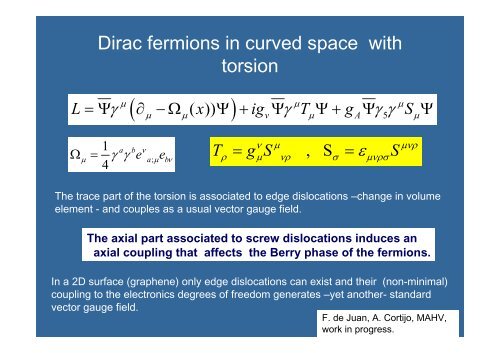General relativity and graphene
General relativity and graphene
General relativity and graphene
Create successful ePaper yourself
Turn your PDF publications into a flip-book with our unique Google optimized e-Paper software.
Dirac fermions in curved space with<br />
torsion<br />
( ( )) ) v A 5<br />
L = Ψγ µ ∂ −Ω x Ψ + ig Ψγ µ T Ψ+ g Ψγ γ<br />
µ S Ψ<br />
µ µ µ µ<br />
Ω =<br />
1<br />
γ γ e<br />
4<br />
e<br />
a b ν<br />
µ a;<br />
µ bν<br />
T = g S , S =ε S<br />
ν µ µνρ<br />
ρ µ νρ σ µνρσ<br />
The trace part of the torsion is associated to edge dislocations –change in volume<br />
element - <strong>and</strong> couples as a usual vector gauge field.<br />
The axial part associated to screw dislocations induces an<br />
axial coupling that affects the Berry phase of the fermions.<br />
In a 2D surface (<strong>graphene</strong>) only edge dislocations can exist <strong>and</strong> their (non-minimal)<br />
coupling to the electronics degrees of freedom generates –yet another- st<strong>and</strong>ard<br />
vector gauge field.<br />
F. de Juan, A. Cortijo, MAHV,<br />
work in progress.
















